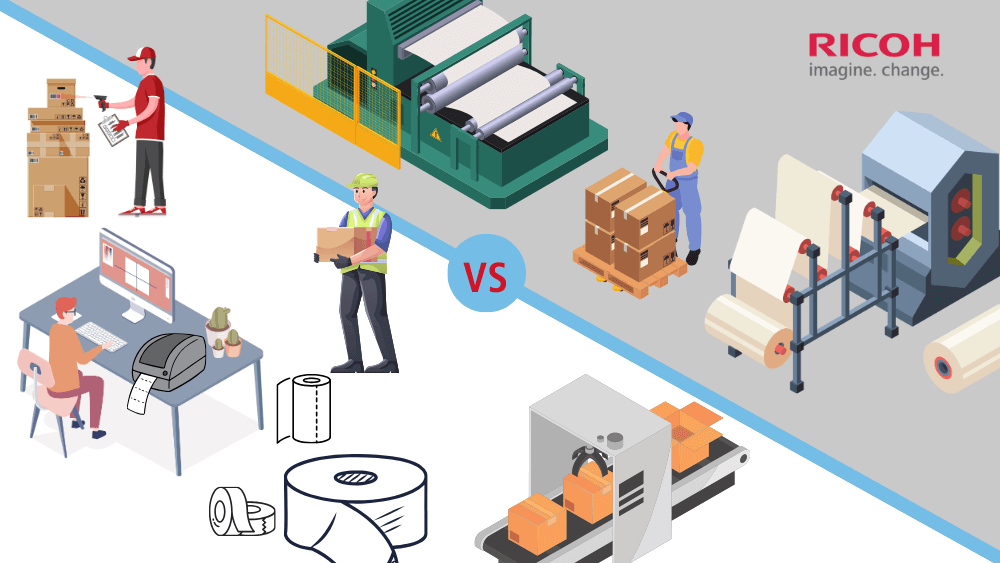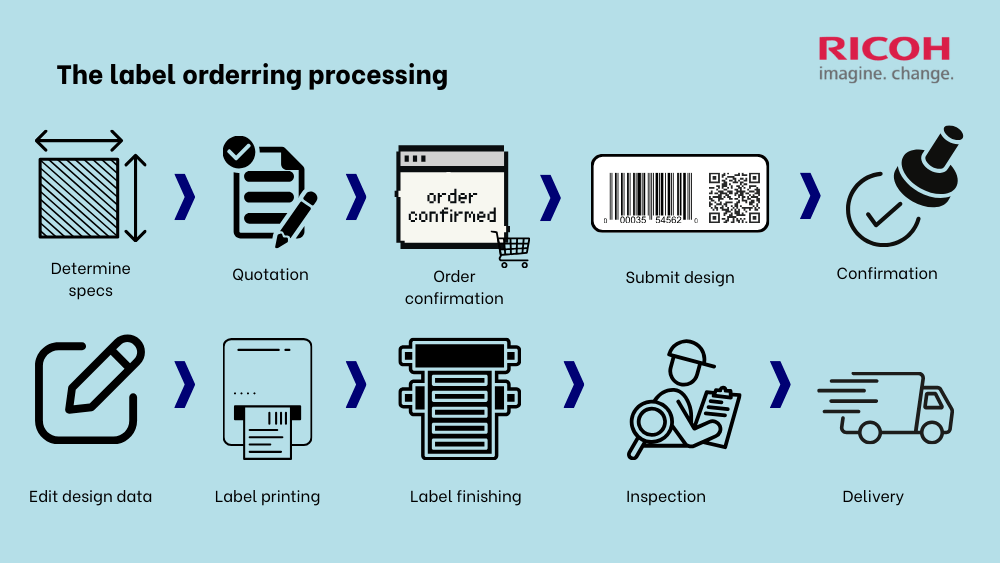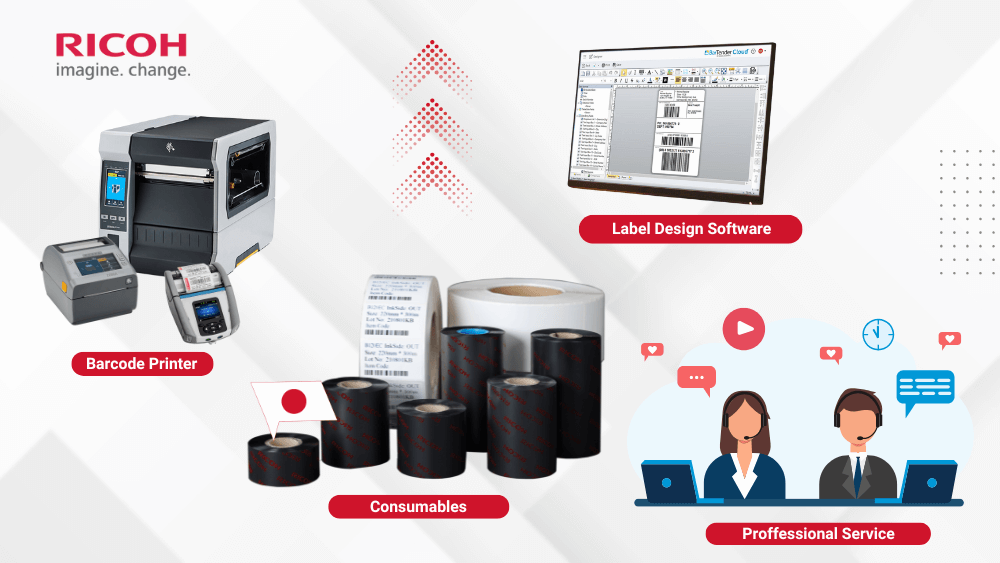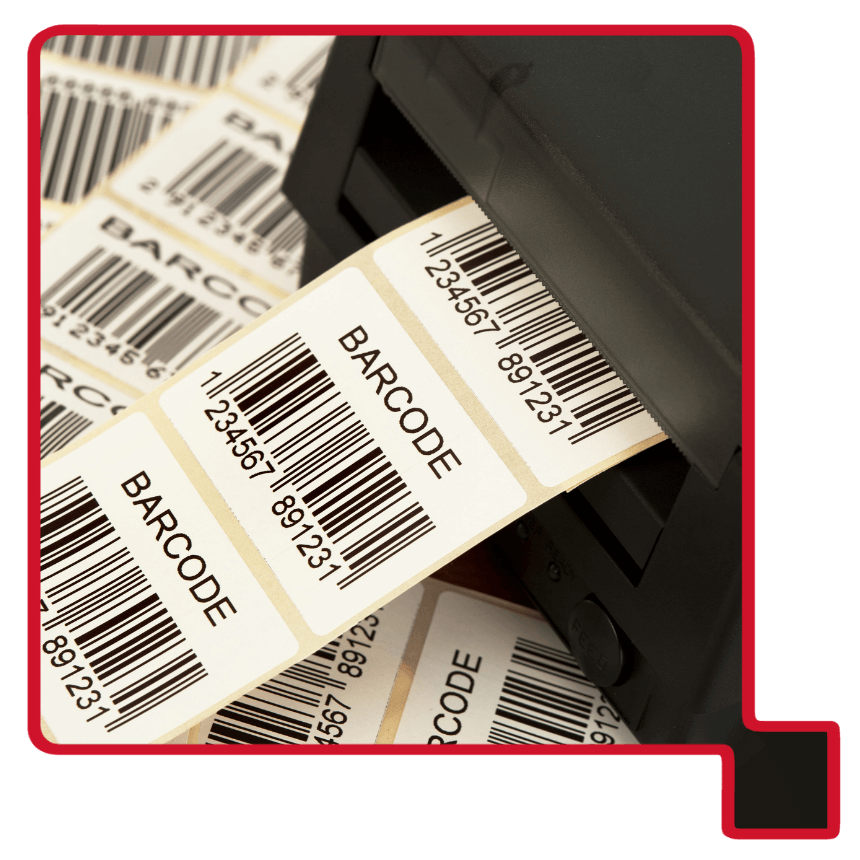
Two Common Options: In-House Printing & Outsourcing
In-House Label Printing
- The business invests in label printers, design/management software (such as BarTender), and supplies (paper, ribbons, etc.).
- Printing takes place directly at the factory or office, on demand, without relying on a third party.
Outsourcing Label Printing
- The business orders from printing houses or label printing service providers.
- The process typically involves: sending requirements, getting a quote, approving a sample, waiting for printing, and receiving the goods. Turnaround time depends on the printer’s production schedule, usually ranging from 4 to 7 days
| Internal Printing | Outsourcing |
| Design & print on-site | Submit request, wait for quotation |
| Print on demand | Approve sample, wait for printing schedule |
| Control quantity & timing | Receive goods & store in inventory |

Pros & Cons of Each Option
To compare the advantages and disadvantages of these two options, Ricoh will analyze them based on the five criteria below:
Speed & Control
- In-house printing: Print instantly when needed, full control over delivery time. Ideal for urgent or frequently changing orders.
- Outsourcing: Dependent on the printing supplier’s production and delivery schedule; delays can occur when changing label designs or quantities.
Design Flexibility & Variable Data
- In-house printing: Easily modify layouts and add variable data (barcodes, QR codes, batch info) right before printing.
- Outsourcing: Any change requires sending a new file for approval, which takes time and may incur extra fees.
Production Cost per Label
- In-house printing: Lower unit cost for frequent small to medium print runs.
- Outsourcing: Cost-effective for very large batches (economies of scale) but less efficient for small or on-demand jobs.
Total Cost of Ownership (TCO)
- In-house printing: Requires upfront investment in printers, software, and supplies; includes maintenance costs. However, it can save money in the long run if printing needs are consistent.
- Outsourcing: No initial investment, but cumulative operating costs may be higher over time.
Quality & Finishing
- In-house printing: Quality depends on printer, ribbon, and media; when chosen correctly, it meets industrial standards.
- Outsourcing: Large-scale industrial printing with consistent quality and advanced finishing options (foil stamping, varnish, die-cutting).

Summary Table:
| Criteria | In-house Printing | Outsourcing |
| Speed & Control | + Instant printing – Requires maintenance & spare supplies | + No equipment investment – Longer lead time, rush fees |
| Design & Data Flexibility | + Variable data, quick edits – Needs template management | + Best for fixed designs – Time-consuming to update |
| Unit Production Cost | + Cost-effective for small runs – Equipment depreciation | + Low cost for huge batches – High cost for small runs |
| TCO (12–24 months) | + Long-term savings if frequent changes – High CapEx | + No CapEx – High OpEx if frequent changes |
| Quality & Finishing | + Excellent for barcodes/durability – Limited premium effects | + Superior for full color/special finishes – Slower for changes |
Note: (+) for advantages and (-) for disadvantages
Which option should you choose?
When to outsource printing
- Printing needs change very little, with a stable design template.
- Each print run is in very large quantities (e.g., over 50,000 labels).
- Requires complex finishing techniques that are difficult to execute in-house.
When to invest in in-house printing
- The business produces many small batches or custom orders.
- Labels frequently need updated product information, barcodes, production dates, or QR codes.
- Want to reduce waiting time and have full control over timelines.
- Want to optimize long-term costs when printing demand remains high.
New trend: Businesses are shifting toward proactive in-house printing
Recent market surveys show a strong movement toward on-site printing:
- According to Smithers Pira 2024, the demand for on-site label printing in the Asia-Pacific region is growing by 8.3% per year, driven by the need for speed and higher personalization.
- The 2023 Finat Radar report shows that over 40% of food manufacturing companies in Europe have partially or fully switched to in-house printing.
This trend is not limited to large corporations. Small and medium-sized enterprises are also leveraging in-house label printing technology to reduce long-term costs, shorten lead times, and improve market responsiveness.
Ricoh’s complete in-house label printing solution
Ricoh Vietnam offers a comprehensive, fully developed, easy-to-deploy, and optimized solution for food manufacturing businesses:
- Zebra printers – Durable, high-performance, and suitable for all production environments.
- Ricoh consumables – High print quality, durable materials in various environments, and compliant with international safety standards.
- BarTender software – Flexible label creation, management, and printing with advanced features.
- Dedicated support services – Label design consultation, on-site demos, and free material testing.

With Ricoh, you get:
- 100% control – Print anytime without relying on third parties.
- Fast response to changes – Easily adjust and integrate as needed.
- Export-compliant labels – Meeting standards such as UL, RoHS, REACH, MSDS, BPA Free, MOAH/MOSH, and more.
- Long-term cost optimization – Reduce intermediaries and avoid dependence on minimum order quantities (MOQs).
Conclusion
There’s no single “right” answer for every business when choosing between in-house printing and outsourcing. However:
- If you want speed, flexibility, and full control, seriously consider investing in in-house printing.
- If your needs are stable and your MOQs are very large, outsourcing is still a good solution.
Tip: Analyze based on total cost of ownership (TCO) and the value of time. In a fast-changing market, in-house printing is becoming a significant competitive advantage.
Contact Ricoh Vietnam today to get a comprehensive advices

Let’s connect
Get in touch with one of our consultants and find out how we can help you to implement a barcode system
Recommended resources for you
.png)
Things You Should Know About Warehouse Management in 2024
Discover the top trend of warehouse management in 2024

Direct Thermal or Thermal Transfer: Which One To Choose?
This article will provide step-by-step guidance to help you navigate the world of thermal printing technology.



